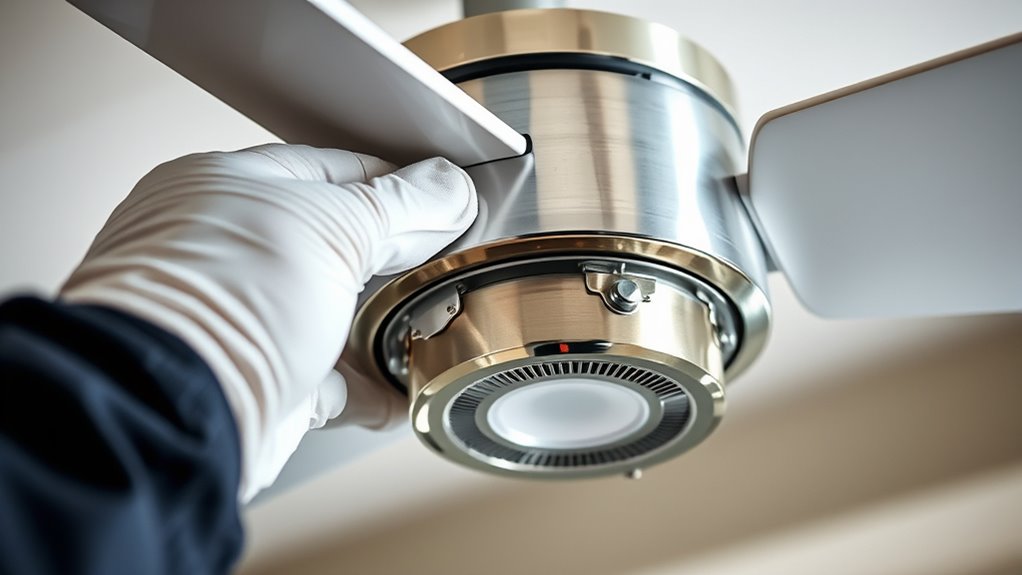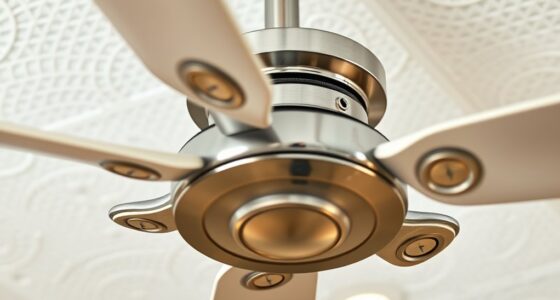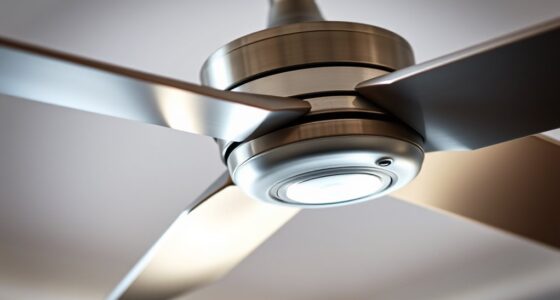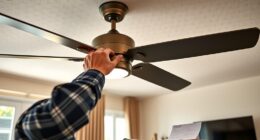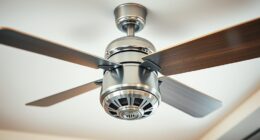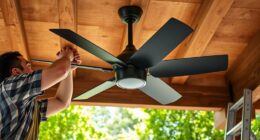To perform your annual ceiling fan tune-up, start by turning off the power and inspecting the blades for dust, dirt, and wobbling, then clean and balance them as needed. Check the motor, lubrication points, and electrical connections for wear or damage, tightening loose parts. After reassembling, turn the fan on to ensure it runs quietly and smoothly. Regular maintenance boosts performance and longevity—stay with us to discover key tips for keeping your fan in top shape.
Key Takeaways
- Turn off power and inspect blades for dust, debris, and wobbling; tighten mounting hardware as needed.
- Clean blades thoroughly and balance them with weights to ensure smooth operation.
- Check motor lubrication points or seals; add oil if applicable, or skip if sealed bearings.
- Examine wiring, connections, and electrical components for damage or corrosion.
- Reassemble, restore power, and test for quiet, efficient, and wobble-free operation.
Ceiling Fan Annual Maintenance Tips

A well-maintained ceiling fan keeps your space comfortable and saves energy, but over time, dust, dirt, and wear can reduce its efficiency. That’s why performing an annual tune-up is vital. The first step is to turn off the fan and verify that the power supply is disconnected to prevent any accidents. Once safe, inspect the fan blades for dust and debris. Clean them thoroughly using a damp cloth. Dusty blades can cause imbalance, leading to wobbling and increased strain on the motor. After cleaning, check the fan blade alignment. If you notice any wobbling or uneven movement, you’ll want to focus on fan blade balancing. This involves adjusting or adding small weights to the blades to guarantee they spin evenly. Proper balancing not only reduces noise but also minimizes wear on the motor and mounting hardware, extending your fan’s lifespan.
Regularly cleaning and balancing ceiling fan blades improves performance and extends lifespan.
Next, focus on the motor itself. Correct motor lubrication is vital for smooth operation. Many fans have oil ports or lubrication points; if yours does, add a few drops of the recommended oil to keep the motor parts moving freely. If your fan has sealed bearings, this step isn’t necessary. While you’re at it, check the mounting brackets for stability. Tighten any loose screws or bolts to prevent wobbling and guarantee the fan hangs securely from the ceiling. Loose mounting can cause unnecessary vibrations, which over time can damage the fan and reduce efficiency. Additionally, fan maintenance including inspecting electrical components, can help prevent safety hazards and improve longevity. Regular inspection of wiring can also help identify potential issues early.
While inspecting the motor, listen for unusual noises such as squeaking or grinding. These sounds often indicate the need for lubrication or other repairs. If you notice these noises, applying lubricant to the motor’s moving parts can greatly improve performance. Additionally, examine the pull chain and switch mechanism; ensure they operate smoothly without sticking. Lubricate moving parts if needed, but avoid over-lubricating, as excess oil can attract dust and dirt, causing more problems down the line.
Finally, check the fan’s overall wiring and connections for corrosion or damage. Faulty wiring can cause electrical issues and reduce the fan’s efficiency. To stay ahead of potential issues, consider preventative maintenance strategies that can identify problems before they escalate. Incorporating local tips such as using appropriate tools and following manufacturer instructions can enhance your maintenance routine. Once everything appears in good condition, reassemble any parts you removed, turn the power back on, and test the fan. It should operate smoothly, quietly, and efficiently. Regular annual tune-ups like these help maintain peak performance, prevent costly repairs, and extend the life of your ceiling fan. Staying proactive with routine maintenance ensures your fan keeps you comfortable while saving energy year-round.
Frequently Asked Questions
How Often Should I Replace My Ceiling Fan’s Blades?
You should replace your ceiling fan’s blades if they become cracked, warped, or notably dusty, which can impact the fan’s balance and safety. Typically, blades last around 10-15 years, but their lifespan depends on usage and maintenance. Regularly inspecting your blades helps prevent unnecessary blade replacement. If you notice persistent wobbling or vibrations, it might be time for blade replacement to guarantee ideal performance and extend your fan’s overall lifespan.
Can I Upgrade My Ceiling Fan’s Motor for Better Efficiency?
Think of your ceiling fan as a heart that keeps your room alive. Upgrading your motor is like giving it a new, stronger heartbeat, boosting efficiency improvement. You can replace your current motor with a more powerful, energy-efficient one to save on energy bills and reduce wear. Just verify compatibility and professional installation. This upgrade can breathe new life into your fan, making it more effective and long-lasting.
What Safety Precautions Are Necessary During Fan Maintenance?
During fan maintenance, you should prioritize electrical safety by turning off the power at the circuit breaker before starting. Always wear personal protective equipment like gloves and safety glasses to protect yourself from sharp blades or accidental electrical contact. Avoid working near live wires, and verify the fan is completely off before handling any components. These precautions help prevent injuries and ensure a safe, effective maintenance process.
Are There Eco-Friendly Options for Ceiling Fan Cleaning?
Cleaning your ceiling fan is like tending a garden—choose eco-friendly cleaning methods to nurture your home and the environment. You can use sustainable materials like microfiber cloths and natural, biodegradable cleaners. Avoid harsh chemicals, opting instead for vinegar and water or plant-based solutions. These eco-friendly options effectively remove dust and grime while reducing your carbon footprint, making your fan sparkle while keeping Mother Earth happy.
How Do I Troubleshoot Unusual Noises From My Ceiling Fan?
If your ceiling fan makes unusual noises, start by checking for fan wobbling or unbalanced blades. Turn off the fan and inspect the blades for dust or damage. Use a blade balancing kit to fix wobbling. Tighten any loose screws or mounting brackets, as loose parts cause noise. If noise persists, the motor might need lubrication or replacement. Regular maintenance keeps your fan running quietly and smoothly.
Conclusion
Think of your ceiling fan as the heartbeat of your room—when it’s well-maintained, it keeps your space lively and comfortable. Regular tune-ups are like tending to a trusted friend, ensuring they stay strong and reliable. By giving your fan this annual care, you’re nurturing a silent guardian that circulates comfort and coolness, quietly working behind the scenes. With each check, you’re weaving a bond that keeps your home’s atmosphere balanced and peaceful for seasons to come.
